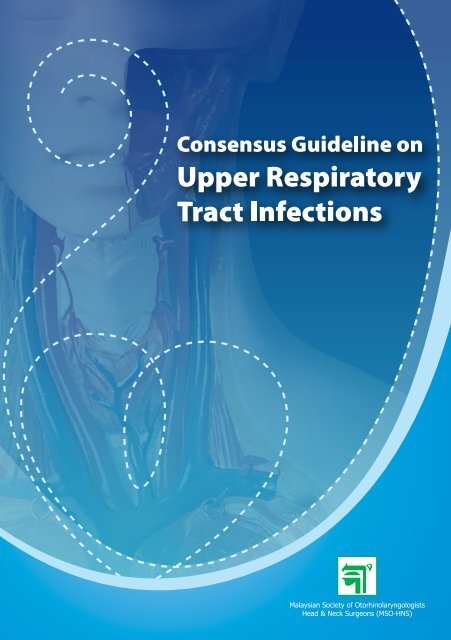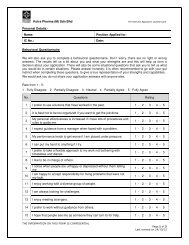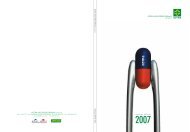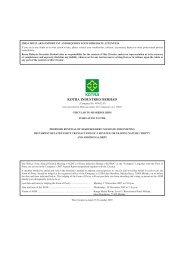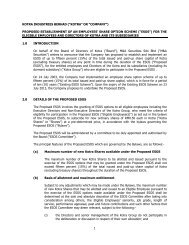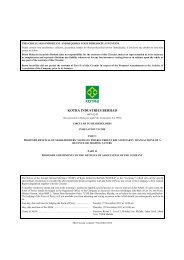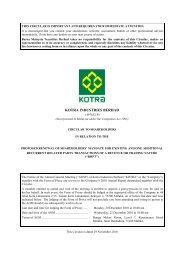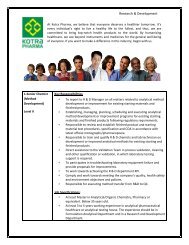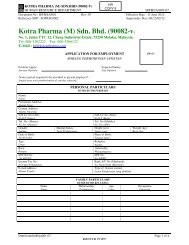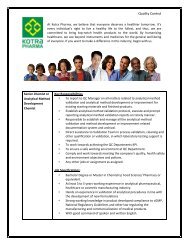URTI CPG Booklet_consensus (English - pdf - 762 Kb) - MSO-HNS
URTI CPG Booklet_consensus (English - pdf - 762 Kb) - MSO-HNS
URTI CPG Booklet_consensus (English - pdf - 762 Kb) - MSO-HNS
- No tags were found...
Create successful ePaper yourself
Turn your PDF publications into a flip-book with our unique Google optimized e-Paper software.
This guideline is meant to be a guide for clinical practice, based on the bestavailable evidence at the time of development. Adherence to this guideline may notnecessarily guarantee the best outcome in every case. Every health care provideris responsible for the management of his/her unique patient based on the clinicalpicture presented by the patient and the management options available locally.This guideline was issued in 2009 and will be reviewed in 2012 or sooner if newevidence becomes available.Electronic version available on the following websites:http://www.msohns.comhttp://www.kotrapharma.com
GUIDELINE DEVELOPMENT AND OBJECTIVEGUIDELINE DEVELOPMENTUpper Respiratory Tract Infection (<strong>URTI</strong>) is a common condition in most primarycare clinics throughout the world. It has an equal distribution among all agesand races. The condition may seem trivial in nature however there are instanceswhere it could possibly lead to serious complications. <strong>URTI</strong> has many etiologiesand causative factors. Medical literature would usually dictate the common causeas viral infection however oral antibiotics are still commonly prescribed for thiscondition. Despite world wide warning and <strong>consensus</strong> on the increase of antibioticresistance, there is still a wide abuse of antibiotics.There are several available guidelines on <strong>URTI</strong> worldwide such as Centre of DiseaseControl and Prevention (CDC) and Infectious Diseases Society of America (IDSA).However, in Malaysia there is no specific clinical practice guideline (<strong>CPG</strong>) availablefor <strong>URTI</strong> which warrants for the need of this guideline.The development group for this guideline consisted of ear, nose and throatspecialists from Ministry of Education and also the private sector phycisians,paediatricians and primary care doctors. During the process of development ofthis guideline, there was active involvement of a review committee.Literature search was carried out at the following electronic databases: PUBMED,Journal full text via Ovid search. In addition, the reference lists of all relevantarticles retrieved were searched to identify further studies. The following free textterms were used either singly or in combination: upper respiratory tract infections,pharyngitis, tonsillitis, sinusitis, rhinosinusitis, otitis media, acute otitis media, etiology,diagnosis, antibiotics, strep score and Rhinosinusitis Task Force.Reference was also made to other guidelines on the management of pharyngitis,rhinosinusitis and otitis media, which include Infectious Diseases Society ofAmerica, Centre of Disease Control and Prevention. This guideline is based largelyon the findings of systematic reviews and meta-analyses in the literature, takinginto consideration local practices.The articles were graded using the levels of evidence scale from U.S/CanadianPreventive Services Task Force and the grading of recommendation was modifiedfrom the Scottish Intercollegiate Guidelines Network (SIGN).Assessment of evidence was done independently by individual members anddiscussed by members of both the development group and review committeebefore the recommendations were formulated. Where the evidence was insufficientthe recommendations were derived by <strong>consensus</strong> of both the development andreview committee.I
The draft guideline was posted on the Ministry Health website for commentand feedback. This guideline has also been presented to the Technical AdvisoryCommittee for Clinical Practice Guidelines, and the Health Technology Assessmentand Clinical Practice Guidelines Council, Ministry of Health Malaysia for review andapproval.OBJECTIVETo provide evidence-based guidance in the management of upper respiratory tractinfection (<strong>URTI</strong>) particularly when it manifests as rhinosinusitis, pharyngitis andAcute Otitis Media. The design of this guideline enables the primary care doctors toclearly understand key points of each condition of rhinosinusitis, pharyngitis andAcute Otitis Media and its management. It will incorporate all the best availableevidences from the medical literature and also guides the primary healthcaredoctors to refer the patients to the specialties accordingly.CLINICAL QUESTIONSHow can rhinosinusitis, pharyngitis and otitis media be assessed and diagnosed?How we treat and manage rhinosinusitis, pharyngitis and Acute Otitis Media?TARGET POPULATIONThis guideline is developed for the management of pharyngitis, rhinosinusitiscommonly found in adults and Acute Otitis Media in both adults and children.TARGET GROUP/USERThis guideline is applicable to all primary health care doctors involved in treatingpatients with upper respiratory tract infection particularly when it manifests asrhinosinusitis, pharyngitis and Acute Otitis Media. This guideline excludes chronicotitis media and otitis externa.II
GUIDELINE DEVELOPMENT GROUPCHAIRPERSONDr Kuljit SinghConsultant Ear, Nose and ThroatPresident of Malaysian Society of Otorhinolaryngology and Head Neck SurgeryMembersDr Anthony James MansulConsultant PaediatricianPrince Court Medical CentreDr Guna RamaPrimary Care DoctorDr Hamidah ShabanConsultant Physicians & Respiratory PhysicianKPJ Selangor Specialist HospitalDr Koh Kar ChaiPrimary Care DoctorChairman of Wilayah Persekutuan Malaysia Medical AssociationDr Shailendra SivalingamLecturer and SpecialistDepartment of ORL – <strong>HNS</strong>University Malaya, Kuala LumpurDr Shashinder Singh Mahinder SinghLecturer and SpecialistDepartment of ORL – <strong>HNS</strong>University Malaya, Kuala LumpurDr. Suzina Sheikh Ab HamidMedical Lecturer & ORL-<strong>HNS</strong> SpecialistDepartment of ORL-<strong>HNS</strong>School of Medical Sciences, Health CampusUniversiti Sains MalaysiaKubang Kerian, KelantanDr P VythilingamPrimary Care DoctorDr Yap Yoke YeowLecturer and ConsultantOtorhinolaryngologistDepartment of SurgeryFaculty of Medical and Health SciencesUniversity Putra MalaysiaIII
REVIEW COMMITTEESThe process of development of this guideline was reviewed by a panel of independent expertreferees, who were asked to comment primarily on the comprehensiveness and accuracy ofinterpretation of the evidence supporting the recommendations in the guideline.EXTERNAL REVIEWERS (alphabetical order)The following external reviewers provided feedback on the draft:Dr Amar Jeet Singh Hazura SinghPrimary Care DoctorDr Anbazhagan KuppusamyConsultant Physician and Infections Diseases SpecialistArunamari Specialist Medical CentreDr Hasbullah Ahdar MDPrimary Care DoctorDr Lim Ming AunPrimary Care DoctorDr Nor Aniza bt Ali ShibramulisiPrimary Care DoctorDr Sharmila KylasamConsultant PaediatricianPrince Court Medical CentreThis <strong>CPG</strong> is endorsed byMalaysian Society of Otorhinolaryngology Head Neck Surgery (<strong>MSO</strong> <strong>HNS</strong>)IV
CONTENTSGuideline Development and ObjectiveGuideline Development GroupReview CommitteeRhinosinusitisPharyngitisAcute Otitis MediaReferencesAcknowledgmentIIIIIV16121822
1.0 RHINOSINUSITISKEY POINTS1. Accurate diagnosis of rhinosinusitis2. Appropriate usage of antibiotics3. Management algorithm for rhinosinusitis1.1 INTRODUCTIONSinusitis is defined as the inflammation of the paranasal sinuses. It has been newlyclassified as rhinosinusitis as the inflammation always involves the nose first. AcuteBacterial Sinusitis is usually a secondary infection resulting from either sinus ostiaobstruction or impaired mucociliary clearance caused by a preceding viral infectionin 0.2 – 2% of cases. In some cases, it can be both 2(Level II) .1.2 CLINICAL FEATURES1.2.1 Etiologic agentsStreptococcus Pneumoniae, Hemophilus Influenzae and MoraxellaCatarrhalis 2(Level III), 7 (Level III) .1.3 DIAGNOSISRhinosinusitis Task Force guidelines (1997, revised in 2002) recommends thediagnosis as follows 9(Level III) .Major symptoms1. Nasal Obstruction or congestion2. Nasal or postnasal discharge/ purulence3. Diminished or absent of sense of smell4. Facial pain, pressure or fullness5. FeverMinor symptoms1. Headache2. Fever3. Halitosis4. Fatigue5. Maxillary dental pain6. Cough7. Ear pain, pressure of fullnessAny patient with one major symptom and two minor symptoms or two majorsymptoms is diagnosed to have rhinosinusitis.Depending on the onset of symptoms, Rhinosinusitis can be divided into thefollowing categories 4(Level II-3) ,6(Level III) :CategoriesAcute rhinosinusitisSubacute RhinosinusitisChronic RhinosinusitisDiagnosis12 weeks (to be referred to an ENT Specialist)1
Figure 1 - Normal nasal cavityFigure 2 - Acute rhinosinusitisFigure 3 - Chronic sinusitisAny patient with symptoms and signs of complications merits immediatereferral to an ENT specialist.Sign of Orbital complications• Conjunctival chemosis• Periorbital swelling• Blurred visionSymptoms of Intracranial complications• Nausea• Persistent vomiting• Altered sensorium• Seizures• Reduced conscious levelWHEN TO REFER TO ENT SPECIALIST?1. Any patient with symptoms or signs of complications2. Any patient who fails to respond after 10 days of second line antibiotics3. Any patient with Subacute or Chronic Rhinosinusitis2
1.4 INVESTIGATIONS• When the diagnosis is in doubt, a paranasal sinus X-ray (OccipitoMental or Watersview) may help by showing evidence of opacification of the sinus suggestive ofan acute infection. It is more readily available than a Computed Tomography (CT)scan of the paranasal sinuses.• Pus swab culture and sensitivity from the nostrils preferably from the middlemeatus to determine the causative organism.1.5 COMPLICATIONSComplications from rhinosinusitis can be as follows 8(Level II-3),6(Level II-2) :Orbital• Preseptal cellulitis• Orbital cellulitis• Subperiosteal abscess• Orbital abscess• Cavernous sinus thrombosisIntracranial• Meningitis• Intracranial abscess• Cranial osteomyelitis1.6 MANAGEMENTa. PainPain relief in the first 24 hours should be achieved with ibuprofen or acetaminophen,because antibiotics typically do not relieve pain in the first 24 hours, and they haveonly a minimal effect on pain subsequently 13(Level III) .15(Level II-3)b. Ancillary treatmentOral decongestantsTopical decongestants• Pseudoephedrine : 60 mg qid or 120 mg bd• Oxymetazoline : 2 sprays bd• Xylometazoline : 2 sprays tds• Phenylephrine : 2 sprays q4h3
1(Level I), 3(Level II-3), 4(Level III), 5(Level II-3), 10(Level II-2),c. Treatment with an antibacterial agent11(Level III), 12(Level III)Nearly all cases resolve without antibiotics. Antibiotics should be reserved formoderate symptoms that are not improving after 7 days or that worsens after 5 to7 days and severe symptoms 5(Level II-3), 12(Level III) .The choice of first-line treatment should be based on the anticipated clinicalresponse as well as the microbiologic flora likely to be present. Antibiotic treatmentshould be continued for a duration of 10 to 14 days 1(Level I), 5(Level II-3) , 10 (Level II-2) .14(level 3)Antibiotic Treatment DosageMild disease and no recent antibiotic useAmoxicillin-clavulanate potassium500mg tds, 875mg bdAmoxicillin500mg tds, 875mg bdCefuroxime250mg or 500mg bdIf beta-lactam allergic:TMP-SMX DS160 to 800mg bdDoxycycline100mg bdAzithromycin 500mg on day 1, 250mg on days 2 through 5Clarithromycin250mg or 500mg bdTelithromycin800mg odModerate disease or recent antibiotic useLevofloxacinMoxifloxacinAmoxicillin-clavulanate (high dose)CeftriaxoneIf beta-lactam allergic:Levofloxacin, MoxifloxacinClindamycin plus rifampin **500mg od400mg od2,000mg bd1g odAs above150 to 450mg qid, 300mg bdrifampin.**Provides coverage for Streptococcus pneumoniae but has no activity against Haemophilus influenzae.Recommendation1. Rhinosinusitis can be diagnosed using Rhinosinusitis Task Force Guidelines.(Grade C)2. To use antibiotics only when moderate symptoms do not improve after 7 daysor worsen after 5 to 7 days and for severe symptoms (Grade B)3. Antibiotic treatment should be continued for 10 to 14 days. (Grade B)4
Management AlgorithmInitial evaluation of symptoms with major and minorsymptoms. Duration of symptoms> 7 days and < 4 weeksSymptomsand signs ofcomplicationsNo previous antibioticusageRecent use of antibiotics< 6 weeks previously ormoderate severityTreatment with first lineantibiotics and ancillarytreatmentTreatment with secondline antibiotics andancillary treatmentReasess after 72 hoursNo ImprovementImprovementSwitch to second lineantibioticsContinue antibioticsfor 10 days withancillary treatmentNo improvement after 72hoursExtend therapy for10–14 days.Consider Sinus ImagingNo ImprovementConsider referral to Otorhinolaryngologistfor further evaluation5
2.0 PHARYNGITISKEY POINTS1. Accurate diagnosis of pharyngitis2. Appropriate usage of antibiotics3. Management algorithm for pharyngitis2.1 INTRODUCTIONAcute pharyngitis is the inflammation of the pharynx, occurring within a 2 weekperiod of infective origin. This definition includes acute adenoiditis and tonsillitis,constituting part of the lymphoid aggregations known as the Waldeyer’s ring thatreside in the pharynx.Figure 4 - Diagrammatic representation of acute tonsillitisAcute pharyngitis accounts for 1-2 percent of all healthcare visits, includingoutpatient department, emergency room and other physician consultations. Acutepharyngitis is mostly viral in origin and self-limiting. Bacterial pharyngitis accountsfor 15-30% of cases in children and 10% of cases in adults 16, Level III; 19, Level III .Most bacterial pharyngitis are secondary to Group A ß-Haemolitic Streptococcusor Staphylococcus pyogenes and responds to antimicrobial therapy which canprevent its attending immune complications such as rheumatic fever, rheumaticheart disease and post-streptococcal acute glomerulonephritis.The role of antimicrobials is therefore limited and should be used judiciously.Imprudent usage of antimicrobial use contributes to an emerging trend ofantimicrobial resistance. Accurate diagnosis of streptococcal pharyngitis istherefore crucial both to prevent such sequelae and to avoid unnecessary use ofantimicrobials.6
2.2 CLINICAL FEATURES2.2.1 The etiologic agents for acute pharyngitis are:Viral : Adenovirus, Epstein-Barr virus V, Influenza A & B virusBacterial : GABHS (Group A ß-Haemolitic Streptococcus or Staphylococcuspyogenes), Moraxella, Hemophilus influenzaOthers : Staph, Bacteroides, E.Coli, diphtheria, syphillis2.2.2 Different types and features of PharyngitisTypesAcute catarrhal tonsillitisAcute parenchymatoustonsillitisAcute follicular tonsillitisAcute membranous tonsillitisFeatures1. Inflamed overlying mucous membrane2. Tonsils not enlarged3. Part of viral pharyngitis1. Substance of the tonsils are infected2. Tonsils diffusely enlarged1. Infection resides in the crypts of the tonsils, filledwith pus2. Yellowish spots with normal intervening mucosa1. Late stage of follicular tonsillitis2. Crypt exudates coalesce on surface of tonsils toform membraneFigure 5 - Acute follicular tonsillitis,evidenced by crypt exudatesFigure 6 - Acute membranous tonsillitis,evidenced by whitish membraneoverlying tonsils7
2.3 DIAGNOSISAcute pharyngitis can be diagnosed by the following symptoms and signs 24, Level III :Signs• Fetid breath• Coated tongue• Hyperemia of soft palate, uvula, andanterior pillars• Tonsils appearing red and swollen.Presence of crypt exudates indicatefollicular tonsillitis, whitish membrane –membranous tonsillitis, and kissingtonsils – parenchymatous tonsillitis• Enlarged or tender upper jugular chain nodesSymptoms• Sore throat• Painful swallowing (odynophagia)• High grade fever with chills• Otalgia• Constitutional symptoms with or withoutmesenteric adenitis• Painful neck swellingWHEN TO REFER TO ENT SPECIALIST?1. Recurrent acute tonsillitis2. Chronic tonsillitis3. Symptoms of Obstructive Sleep Apnoea (OSA)4. Unilateral tonsil enlargement5. Complications of tonsillopharyngitisThe gold standard for streptococcal pharyngitis is throat culture. However, Throatculture is recommended only in an outbreak situation as a method of epidemiologicstudy and for patients in whom gonococcal disease is possible 25, Level III . However, therehave been significant improvements in sensitivity and specificity of rapid antigendetection testing (RADT). To facilitate management, the modified Centor score canhelp clinicians determine which patients should need no testing, throat culture/rapidantigen detection testing, or empiric treatment with antibiotics.*Rapid Antigen Detection Testing (RADT) currently is not widely available in Malaysia. By the<strong>consensus</strong> of this guideline development committee, in the absence of this test, empiricaltreatment with antimircobials may be instituted in a score of 3 or above.8
Strep Score for Group a Beta-Hemolytic Streptococcus PharyngitisSymptomsPointsFever +1Absence of cough +1Cervical adenopathy +1Tonsillar exudates +1Patient’s age45 years - 1Total score:Score-1 or 01, 2, or 34 or 5Probabilityof strep (%)110 to 3551Action• No further testing or treatment• Rapid antigen testing; treatment based on result• Consider empiric treatment or rapid antigen testingStrep Score for diagnosing GABHS Pharyngitis 23, Level III (taken from Wong DM, Blumberg DA,Lowe LG. Guidelines for the use of antibiotics in acute upper respiratory tract infections. AmFam Physician. Sep 15 2006;74(6):956-966)2.4 INVESTIGATIONSCulture and sensitivityThroat swab for culture and sensitivity is recommended for severe or persistentdisease or in an outbreak situation as a method of epidemiologic study and forpatients in whom gonococcal disease is possible 24, Level III .2.5 COMPLICATIONSFeatures of complications of tonsillitis• Neck abscess• Dysphagia or deviated uvula [peritonsillar abscess]• Otalgia or ear discharge [acute otitis media]• Chest pain, abnormal movements, subcutaneous nodules, erythema marginatum,migrating polyarthritis [rheumatic fever]• Oliguria and shortness of breath [glomerulonephritis]9
2.6 MANAGEMENTPhysicians should limit antimicrobial prescriptions to patients who are most likelyto have streptococcal pharyngitis with the intention of preventing rheumatic fever,acute glomerulonephritis and suppurative complications.Penicillin is the first choice, and erythromycin should be used in patients who areallergic to penicillin. A 10-day course of penicillin V remains the treatment of choicefor GABHS pharyngitis. However, amoxicillin is an acceptable alternative because ofavailability, taste and the increased likelihood of compliance 19, Level III; 25, Level III .Throat cultures should not be performed for the routine primary evaluation ofadults with pharyngitis.All patients with pharyngitis should be offered appropriate doses of analgesics,antipyretics and other supportive care.There is no evidence of group A beta-hemolytic streptococcus resistance to ortolerance of penicillin, and erythromycin resistance rates are low 19, Level III; 25, Level III .Antibiotic Treatment Dosage Duration1 st Line TreatmentPenicillin V 500mg tds 10 daysPenicillin G benzathine 1.2 million units IM once2 nd Line TreatmentAmoxicillin 500mg bd or 250mg 3 tds 10 daysErythromycin ethylsuccinate 400mg qid 10 daysOral CephalosporinsClindamycin 300mg bd 10 daysRecommendation1. Use Strep Score to diagnose Group A Beta Haemolytic StreptococcuvsPharyngitis for the use of antibiotics. (Grade C)2. Oral Penicillin V for 10 days is the treatment of choice for suspected or provenGABHS pharyngitis. Amoxycillin is an acceptable alternative while oralErythromycin should be used in known penicillin allergy. (Grade C)10
Management AlgorithmStrepScore=3SymptomaticTreatment:• Analgesic• Antipyretic• HydrationAntimicrobialtherapyNo history ofpenicillin allergy:Oral penicillin VorOral amoxycillinHistory ofpenicillin allergyMild (non-type I):CephalosporinSevere(anaphylacticor type Ihypersensitivity):Erythromycin11
3.0 ACUTE OTITIS MEDIAKEY POINTS1. Accurate diagnosis of acute otitis media2. Appropriate choices of antibiotics3. Management of algorithm for Acute Otitis Media3.1 INTRODUCTIONAcute Otitis Media (AOM) is the most frequently occurring bacterial illnessin children 33, Level I; 37, Level II-2 . For the clinician, the choice of a specific antibacterialagent has become a key aspect of management due to rising concerns about theincreasing rates of antibacterial resistance.This clinical practice guideline provides recommendations to primary careclinicians for the management of uncomplicated AOM particularly in children from2 months through 12 years of age. Occasionally, an adult with no previous historyof ear disease, but with an acute viral <strong>URTI</strong>, presents with AOM. The managementin older children could be applied to adult 31, Level I; 35, Level III .3.2 CLINICAL FEATURESA diagnosis of AOM requires a history and findings as stated below 27, Level I .Signs and Symptoms of AOM1. Recent, usually abrupt, onset of signs and symptoms of middle-ear inflammation andmiddle-ear effusion.2. The presence of middle-ear effusion that is indicated by any of the following:• Bulging of the tympanic membrane• Limited or absent mobility of the tympanic membrane• Air fluid level behind the tympanic membrane• Otorrhea3. Signs or symptoms of middle-ear inflammation as indicated by either• Distinct erythema of the tympanic membrane OR• Distinct otalgia (discomfort clearly referable to the ear[s] that results in interferencewith or precludes normal activity or sleep)12
Figure 7 - Normal tympanic membraneFigure 8 - Otitis media effusionIt is highly important to exclude AOM in a febrile and irritable infant by earexamination.Clinicians should discriminate between Otitis Media with Effusion (OME) and AcuteOtitis Media (AOM) 34, Level II-2 . AOM is considered distinct from otitis media witheffusion (OME), which is defined as the presence of fluid in the middle ear withoutsigns or symptoms of acute ear infection 26, Level I . When OME is mistakenly diagnosedas AOM, antibacterial agents may be prescribed unnecessarily 30, Level I; 38, Level III .WHEN TO REFER TO ENT SPECIALIST?1. Recurrent acute otitis media2. Persistent otorrhea3. Concerns about mastoiditis or other complications of AOM4. Perceived need for tympanocyntesis and/or myringotomy5. Abnormal audiological evaluation3.3 COMPLICATIONSAOM may have potentially serious complications including mastoiditis, meningitis,and intracranial abscess formation.3.4 MANAGEMENTa. Assessment of painIf pain is present, the clinician should recommend treatment to reduce pain 27, Level I .Pain relief in the first 24 hours should be achieved with ibuprofen or acetaminophen,because antibiotics typically do not relieve pain in the first 24 hours, and they have onlya minimal effect on pain subsequently. By 24 hours, about 60% of children have painrelief, and this percentage increases to 80% to 90% within a few days 32, Level II-2 ; 28, Level I .13
. Observation without use of antibacterial agentsObservation without use of antibacterial agents (for 48 to 72 hours and limitingmanagement to symptomatic relief) in a child with uncomplicated AOM is anoption for selected children based on diagnostic certainty, age, illness severity, andassurance of follow-up 27, Level I .Criteria for Initial Antibacterial Agent Treatment or Observation in ChildrenWith AOMAge Diagnosis of AOM is uncertain Diagnosis of AOM is certain
Once the patient has shown clinical improvement, follow-up is based on the usualclinical course of AOM. Persistent middle-ear effussion after resolution of acutesymptoms is common and should not be viewed as a need for active therapy. Twoweeks after an episode of AOM, 60% to 70% of children have middle-ear effussion,decreasing to 40% at 1 month and 10% to 25% after 3 months 36, Level I .Please see Management Algorithm for summary.e. Management in adultCurrent best practice recommends amoxicillin for uncomplicated AOM; continuingor switching to an alternative antibiotic based on clinical response after 48 hoursof therapy; and selection of second line antibiotics as first line choices when thepatient has already been on an antibiotic within the previous month or is otitisprone. Preferred second-line agents frequently noted in various guidelines includeamoxicillin/clavulanate and cefuroxime 35, Level III .Recommendation• The diagnosis of AOM requires a history of the acute onset of symptoms and signsof middle-ear inflammation and effusion. (Grade A)• Analgesia is a critical part of the treatment of AOM in children. Acetaminophenand ibuprofen are first-line treatments for mild to moderate pain. (Grade B)• Amoxicillin at a dose of 80 to 90 mg/kg/day should be the first-line antibiotic usedfor AOM in children. (Grade A)• 10 days of antibiotic treatment should be used for children younger than 6 years.(Grade C)• Antibiotic courses of 5 to 7 days may be chosen for children older than 6 yearswith mild or moderate AOM. (Grade A)• For management of uncomplicated AOM in adults, amoxicillin is the current bestpractice and the preferred second-line agents are amoxicillin/clavulanateand cefuroxime. (Grade C)15
Recommended Antibacterial Agents for Patients Who Are Being Treated Initially With Antibacterial Agents orWho Have Failed 48 to 72 Hours of Observation or Have Failed Initial Management With Antibacterial Agents 28, Level I .Temperature≥39 º Cand/orSevere OtalgiaAt Diagnosis for Patients Being TreatedInitially With Antibacterial AgentsClinically Defined Treatment Failure at48–72 Hours After Initial ManagementWith Observation OptionClinically Defined Treatment Failure at48–72 Hours After Initial ManagementWith Antibacterial AgentsAlternative forPenicillin AllergyAlternative forPenicillin AllergyRecommended Recommended RecommendedAlternative forPenicillin AllergyNoAmoxicillin(80–90mg/kg perday in 3 divideddoses)* Cefuroxime(30mg/kg per dayin 2 divided doses);#Azithromycin(10mg/kg per dayon day 1 followedby 5mg/kg per dayfor 4 days as asingle daily dose);#Clarithromycin(15mg/kg per dayin 2 divided doses)Amoxicillin(80–90mg/kg perday in 3 divideddoses)*Cefuroxime(30mg/kg per dayin 2 divided doses);#Azithromycin(10mg/kg per dayon day 1 followedby 5mg/kg per dayfor 4 days as asingle daily dose);#Clarithromycin(15mg/kg per dayin 2 divided doses)Amoxicillin-clavulanate (90mg/kgper day ofamoxicillin with6.4mg/kg per dayof clavulanate in 2divided doses)* Ceftriaxone(50mg/kg, 3 days;#ClindamycinYesAmoxicillinclavulanate(90mg/kg per dayof amoxicillin with6.4mg/kg per dayof clavulanate in 2divided doses)Ceftriaxone(50mg/kg, 1 or 3days)Amoxicillinclavulanate(90mg/kg per dayof amoxicillin with6.4mg/kg per dayof clavulanate)Ceftriaxone(50mg/kg 1 or 3days)Ceftriaxone(50mg/kg 1 or 3days)Tympanocentesis,Clindamycin*Non-anaphylactic reaction #Severe penicillin allergy16
Management AlgorithmChild aged 2 months – 12 years with uncomplicated AOMIs pain present?YesNoTreatment toreduce painIs observation anappropriate initialtreatment option? *NoDoes thechildhave fever >39 º Cand/or moderateor severe otalgiaNoAmoxicillinat a dose of80-90mg/kg/day is the initialantibacterial ofchoice for mostchildrenYesYesObserved for 48 to 72 hourswith assurance of appropriatefollow-upManage appropriately withantibacterial therapy.(See Table 3)Did patient respondto initial treatmentintervention (eitherantibacterial treatment orobservation)?Yesfollow-up asappropriateNoReassess andconfirmsdiagnosis ofAOMIs diagnosis ofAOM confirmed?YesNoAssess for othercauses of illnessand manageappropratielyInitiate antibacterial treatment for children initiallymanaged with observation or change antibacterialtreatment for patients initially managed withantibacterial therapy. (See Table 3)17
REFERENCES1. Anon JB, Jacobs MR, Poole MD, Ambrose PG, Benninger MS, Hadley JA, et al(2004) Antimicrobial treatment guidelines for acute bacterial rhinosinusitis.Otolaryngol Head Neck Surg 130(1 suppl): 1-45.2. Brook I. (2005) The role of bacteria in chronic rhinosinusitis. Brook I -Otolaryngol Clin North Am - 01-DEC-2005; 38(6): 1171-923. Cervin, A. (2005) Anti-inflammatory effects of macrolide antibiotics in thetreatment of chronic rhinosinusitis. - Otolaryngol Clin North Am - 01-DEC-2005; 38(6): 1339-504. Jackson, L.L. (2005) Classification and management of rhinosinusitis and itscomplications. Otolaryngol Clin North Am - 01-DEC-2005; 38(6): 1143-535. Karlowsky JA, Draghi DC, Thornsberry C, Jones ME, Critchley IA, Sahm DF.(2002) Antimicrobial susceptibilities of Streptococcus pneumoniae,Haemophilus influenzae and Moraxella catarrhalis isolated in two successiverespiratory seasons in the US. Int J Antimicrob Agents ; 20: 76-856. Lanza DC, Kennedy DW. (1997) Adult rhinosinusitis defined. OtolaryngolHead Neck Surg ; 117(3 pt 2): S1-77. Low DE, Desrosiers M, McSherry J, Garber G, Williams JW Jr, Remy H, et al.(1997) A practical guide for the diagnosis and treatment of acute sinusitis.CMAJ 156(suppl 6): S78. Osguthorpe, J.D. Rhinosinusitis..- American Academy of Otolaryngology-Head and Neck Surgery Fifth Edition9. Otolaryngology Head and Neck Surgery. 1997 Sep 117 (3 Pt 2): S1-68 Reportof the Rhinosinusitis Task Force Committee Meeting.199610. Poole MD. A mathematical therapeutic outcomes model for sinusitis.Otolaryngol Head Neck Surg 2004;130(1 suppl): 46-5011. Rosen, F., Ryan M. (2002) Rhinosinusitis: Current Concepts. - Grand RoundsPresentation, UTMB, Dept. of Otolaryngology. May 112. Scadding, G.K. (2004) Medical management of chronic rhinosinusitisScadding GK - Immunol Allergy Clin North Am - 01-FEB-2004; 24(1): 103-1818
13. Scheid DC, Hamm RM. (2004) Acute bacterial rhinosinusitis in adults:part I. Evaluation. Am Fam Physician; 70:1685-9214. Scheid DC, Hamm RM. (2004) Acute bacterial rhinosinusitis in adults:part II. Treatment. Am Fam Physician; 70: 1698-170415. Smith MB, Feldman W. (1993) Over-the-counter cold medications. Acritical review of clinical trials between 1950 and 1991. JAMA; 269: 2258-6316. Bisno AL, Gerber MA, Gwaltney JM, Jr., Kaplan EL, Schwartz RH. Diagnosisand management of group A streptococcal pharyngitis: a practice guideline.Infectious Diseases Society of America. Clin Infect Dis. Sep 1997; 25(3): 574-58317. Ebell MH, Smith MA, Barry HC, Ives K, Carey M. The rational clinical examination.Does this patient have strep throat? Jama. Dec 13 2000; 284(22): 2912-291818. Ebell MH. Strep throat. Am Fam Physician. Sep 1 2003;68(5):937-938. McCaig LF,Hughes JM. Trends in antimicrobial drug prescribing among office-basedphysicians in the United States. Jama. Jan 18 1995; 273(3): 214-21919. Gonzales R, Bartlett JG, Besser RE, et al. Principles of appropriate antibioticuse for treatment of acute respiratory tract infections in adults: background,specific aims, and methods. Ann Intern Med. Mar 20 2001; 134(6): 479-48620. Hoffman JR, Cooper RJ, Gonzales R. Choosing an optimal strategy to assessand treat adults with pharyngitis. Clin Infect Dis. Jan 15 2003; 36(2): 235-23621. McCaig LF, Hughes JM. Trends in antimicrobial drug prescribing amongoffice-based physicians in the United States. Jama. Jan 18 1995; 273(3): 214-21922. McIsaac WJ, Kellner JD, Aufricht P, Vanjaka A, Low DE. Empirical validation ofguidelines for the management of pharyngitis in children and adults. Jama.Apr 7 2004; 291(13): 1587-159523. Shapiro NL, Cunningham MJ. Streptococcal pharyngitis in children.Curr Opin Otolaryngol Head Neck Surg. 1995; 3(369)24. Wiatrak BJ, Wooley AL. Pharyngitis and Adenotonsillar Disease. PediatricOtolaryngology. 3rd ed: Mosby; 199925. Wong DM, Blumberg DA, Lowe LG. Guidelines for the use of antibiotics inacuteupper respiratory tract infections. Am Fam Physician. Sep 152006; 74(6): 956-96619
26. American Academy of Family Physicians; American Academy ofOtolaryngology-Head and Neck Surgery; American Academy of PediatricsSubcommittee on Otitis Media With Effusion.Otitis media with effusion. Pediatrics 2004; 113: 1412-2927. American Academy of Pediatrics and American Academy of FamilyPhysicians; Subcommittee on Management of Acute Otitis Media. Diagnosisand management of acute otitis media. Pediatrics 2004; 113: 1451-6528. American Academy of Pediatrics, Committee on Psychosocial Aspects ofChild and Family Health; Task Force on Pain in Infants, Children, and Adolescents.The assessment and management of acute pain in infants, children, andadolescents. Pediatrics. 2001; 108: 793–79729. Dowell SF, Butler JC, Giebink SG, et al. Acute otitis media: management andsurveillance in an era of pneumococcal resistance—a report from the DrugresistantStreptococcus pneumoniae Therapeutic Working Group. PediatrInfect Dis J. 1999; 18: 1–930. Dowell SF, Marcy SM, Phillips WR, Gerber MA, Schwartz B. Otitis media—principles of judicious use of antimicrobial agents. Pediatrics. 1998; 101: 165–17131. Froom J, Culpepper L, Jacobs M, DeMelker RA, Green LA, van Buchem L, et al.Antimicrobials for acute otitis media? A review from the InternationalPrimary Care Network. BMJ 1997; 315: 98-10232. Hayden GF, Schwartz RH. Characteristics of earache among children withacute otitis media. Am J Dis Child. 1985; 139: 721–72333. Marcy M, Takata G, Chan LS, et al. Management of Acute Otitis Media.Evidence Report/Technology Assessment No. 15. Rockville, MD: Agency forHealthcare Research and Quality; 2001. AHRQ Publication No. 01-E01034. Pichichero ME. Diagnostic accuracy, tympanocentesis training performance,and antibiotic selection by pediatric residents in management of otitismedia. Pediatrics. 2002; 110: 1064–107035. Pichichero ME, Casey JR. Acute otitis media disease management. MinervaPediatr. 2003 Oct; 55(5): 415-3836. Rosenfeld, Richard M. MD, MPH; Kay, David MD. Natural History of UntreatedOtitis Media. Laryngoscope. 113(10): 1645 -1657, October 200320
37. Schappert SM. Office visits for otitis media: United States, 1975–90. Adv Data.1992; 214: 1–1938. Wald ER. Acute otitis media: more trouble with the evidence. Pediatr InfectDis J. 2003; 22: 103–10421
ACKNOWLEDGEMENTSThe committee for this guideline would like to express their gratitude and appreciationto the following for their contributions:• Panel of external reviewers who reviewed the draft.DISCLOSURE STATEMENTThe panel members have completed disclosure forms. (Details are available uponrequest from the Guideline Secretariat)SOURCES OF FUNDINGThe development of the Consensus Guideline on Upper Respiratory Tract Infectionis supported by an educational grant from Kotra Pharma Sdn. Bhd.22
23NOTES
III-1II-2II-3IIILEVELS OF EVIDENCE SCALEEvidence obtained from at least one properly randomized controlled trialEvidence obtained from well-designed controlled trails without randomizationEvidence obtained from well-designed cohort or case-control analytic studiespreferably from one center or research groupEvidence obtained from multiple time series with or without the intervention.Dramatic results in uncontrolled experiements (Such as the results of theintroduction of penicillin treatment in 140s) could also be regarded as thistype of evidenceOpinions of respected authorities, based on clinical exeperience;descriptivestudies and case reports; or reports of expert committeesSOURCE: U.S/ CANADIAN PREVENTIVE SERVICES TASK FORCEABCGRADES OF RECOMMENDATIONAt least one meta analysis, systematic review, or RCT, or evidence rated asgood and directly applicable to the target populationEvidence from well conducted clinical trials, directly applicable to the targetpopulation, and demonstrating overall consistency of results; or evidenceextrapolated from meta analysis, systematic review, or RCTEvidence from expert committee report, or opinions and / or clinicalexperiences of respected authorities; indicates absence of directly applicableclinical studies of good qualitySOURCE: MODIFIED FROM THE SCOTTISH INTERCOLLEGIATE GUIDELINES NETWORK(SIGN)
Supported by an educational grant from


